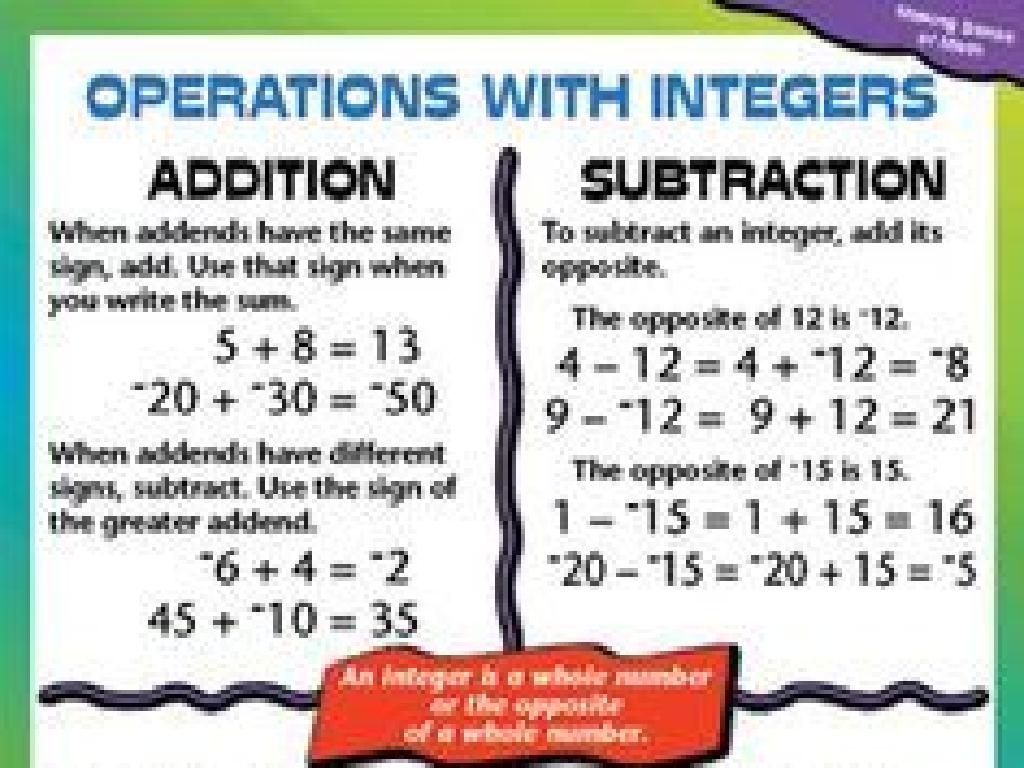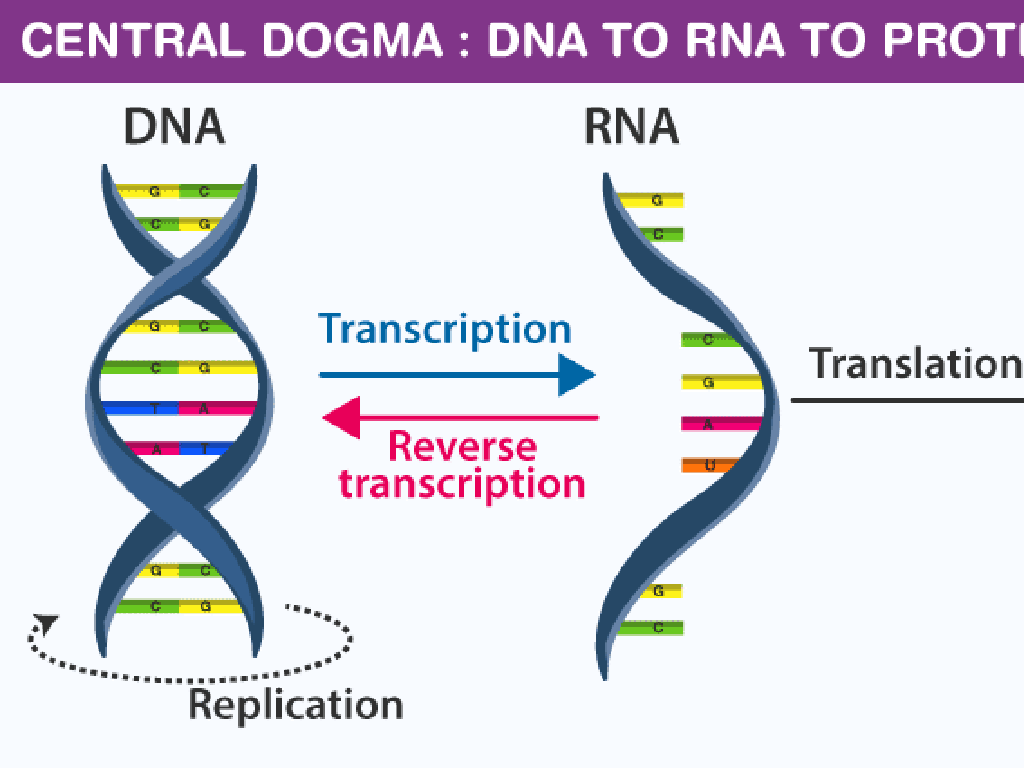Compare Sums And Differences Of Fractions
Subject: Math
Grade: Fifth grade
Topic: Add And Subtract Fractions
Please LOG IN to download the presentation. Access is available to registered users only.
View More Content
Comparing Sums and Differences of Fractions
– Quick recap of fractions
– Fractions represent parts of a whole
– Today’s goal: Compare fractions
– Learn to determine which is larger or smaller
– Understanding why comparison matters
– It helps in making informed decisions
– Applying comparison in real life
– Like sharing pizza or measuring ingredients
|
Begin with a brief review of what fractions are, ensuring students recall that fractions represent parts of a whole. Today’s objective is to learn how to compare the sums and differences of fractions, which is a crucial skill in math. Emphasize the importance of comparing fractions in everyday decision-making, such as dividing a pizza among friends or measuring ingredients for a recipe. Provide examples and encourage students to think of situations where they might need to compare fractions. This will help them understand the practical applications of the concepts they are learning.
Adding Fractions: Like and Unlike Denominators
– Review adding with same denominators
– Add numerators when denominators match, e.g., 1/3 + 2/3 = 3/3
– Example with different denominators
– Find a common denominator before adding, e.g., 1/2 + 1/3
– Practice: Add 1/4 + 3/8
– Step by step, let’s solve 1/4 + 3/8 together
|
Begin with a review of adding fractions with like denominators, emphasizing that only the numerators are added while the denominator remains the same. Next, introduce adding fractions with different denominators by finding a common denominator, which allows the fractions to be combined. Use visual aids or fraction strips if possible to illustrate this concept. For the practice problem, guide students through the process of finding a common denominator for 1/4 and 3/8, converting the fractions, and then adding them together. Encourage students to work through the problem on their own first, then review the steps as a class.
Subtracting Fractions
– Review subtraction with like denominators
– Remember to subtract the numerators directly
– Example with different denominators
– Find a common denominator before subtracting
– Practice: 5/8 – 1/4
– Step-by-step guide: Convert 1/4 to 2/8, then subtract from 5/8
|
Begin with a quick review of subtracting fractions that have the same denominator, emphasizing that only the numerators are subtracted while the denominator remains the same. Next, introduce an example that involves subtracting fractions with different denominators, highlighting the need to find a common denominator first. For the practice problem, guide students through the process of converting 1/4 to 2/8 so that both fractions have a common denominator, making it easier to subtract. This slide aims to reinforce the concept of fraction subtraction and prepare students for more complex problems involving different denominators.
Comparing Sums of Fractions
– How to find the greater sum
– Add fractions and compare results
– Use number lines for comparison
– Visualize sums on a number line
– Example: 1/2 + 2/3 vs 3/4 + 1/5
– Which is larger: 7/6 or 19/20?
|
This slide is aimed at teaching students how to compare the sums of different sets of fractions. Start by explaining the process of adding fractions with unlike denominators, finding a common denominator, and then adding the numerators. Emphasize the importance of simplifying fractions where possible. Introduce the use of number lines as a visual aid to help students better understand and compare the size of fractions. Use the example provided to walk through the process step by step, showing how to add each set of fractions and then compare the sums. Encourage students to practice with additional examples and to use number lines to check their work.
Comparing Differences of Fractions
– Determine greater difference
– Subtract fractions and compare results
– Use number lines for comparison
– Visualize differences on a number line
– Example: 7/8 – 1/4 vs. 5/6 – 1/3
– Which is greater: 3/8 (7/8 – 1/4) or 1/2 (5/6 – 1/3)?
|
This slide aims to teach students how to compare the differences between two sets of fractions by subtraction and visualization. Start by explaining the steps to subtract fractions: find a common denominator, subtract the numerators, and simplify if possible. Then, show how to place the resulting differences on a number line to see which is greater. Use the example provided to walk through the process step by step. Encourage students to solve the example themselves and verify their answers using number lines. This will help them understand the concept of comparing differences visually and numerically.
Let’s Practice Together: Comparing Fractions
– Class activity: Compare fractions
– Work in pairs on Set A and Set B
– Solve and find which is greater
– Is 3/5 + 1/2 greater than 2/3 + 3/8? How about 4/7 – 2/5 and 5/8 – 1/4?
– Discuss your strategies with the class
|
This class activity is designed to encourage collaborative learning as students work in pairs to solve fraction problems. Set A and Set B each contain two problems that students will solve and then compare to determine which sum or difference is greater. Provide guidance on finding common denominators and ensuring proper fraction addition and subtraction. After solving, facilitate a class discussion where pairs share their strategies and solutions. This will help students learn from each other and reinforce their understanding of comparing the sums and differences of fractions.
Class Activity Debrief: Fractions
– Discuss solutions together
– Share effective strategies
– Did using visuals or number lines help?
– Address questions or challenges
– Any tricky problems or confusing parts?
– Reflect on the learning process
|
This slide is meant to facilitate a class discussion following a hands-on activity with fractions. Start by reviewing the solutions to the problems tackled during the activity. Encourage students to share the strategies they found most effective, such as drawing pictures, using number lines, or breaking down problems into smaller parts. Open the floor for any questions or challenges the students may have encountered. This is a crucial step to ensure understanding and to address any misconceptions. Lastly, have students reflect on what they’ve learned about comparing sums and differences of fractions. Possible activities could include peer teaching, group problem-solving, or individual reflection on the most challenging aspects of the lesson.
Homework and Next Steps: Fractions
– Complete the worksheet on comparing fractions
– Practice comparing sums and differences
– Next class: Multiplying and Dividing Fractions
– We’ll explore how to multiply and divide fractions
– Keep practicing your fraction skills
– Stay curious about math!
|
For homework, students are tasked with completing a worksheet that focuses on comparing the sums and differences of fractions, reinforcing today’s lesson. The next class will introduce the concepts of multiplying and dividing fractions, building upon their understanding of fraction operations. Encourage students to practice regularly to improve their skills and maintain a curious mindset towards learning math. Provide several activity options for different learning styles, such as visual fraction models, word problems, and interactive online exercises. Remind students that practice is key to mastery and that their curiosity will drive their learning journey in mathematics.





